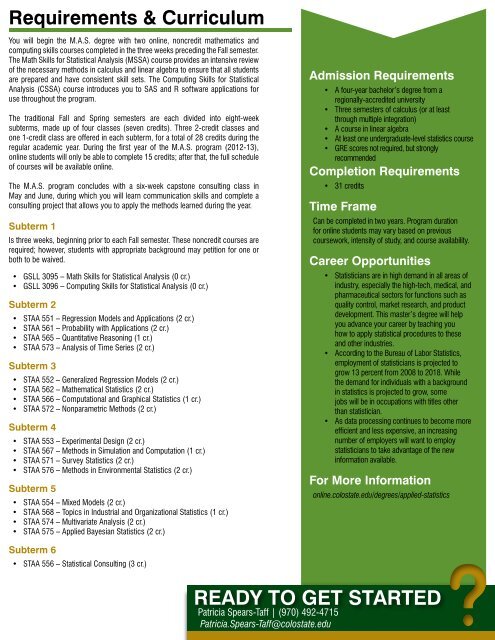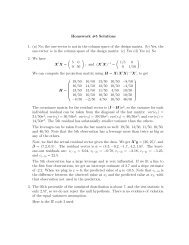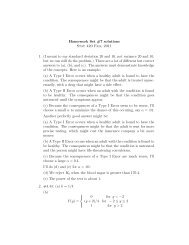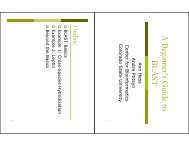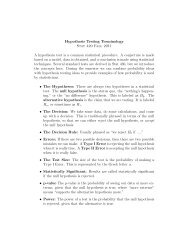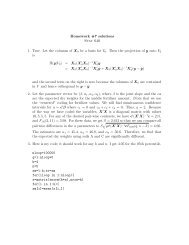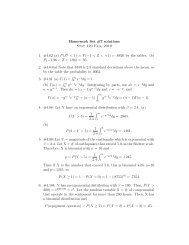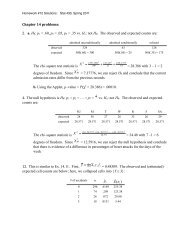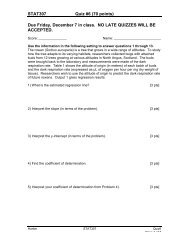Master of Applied Statistics (MAS)
Master of Applied Statistics (MAS)
Master of Applied Statistics (MAS)
You also want an ePaper? Increase the reach of your titles
YUMPU automatically turns print PDFs into web optimized ePapers that Google loves.
Requirements & Curriculum<br />
You will begin the M.A.S. degree with two online, noncredit mathematics and<br />
computing skills courses completed in the three weeks preceding the Fall semester.<br />
The Math Skills for Statistical Analysis (MSSA) course provides an intensive review<br />
<strong>of</strong> the necessary methods in calculus and linear algebra to ensure that all students<br />
are prepared and have consistent skill sets. The Computing Skills for Statistical<br />
Analysis (CSSA) course introduces you to SAS and R s<strong>of</strong>tware applications for<br />
use throughout the program.<br />
The traditional Fall and Spring semesters are each divided into eight-week<br />
subterms, made up <strong>of</strong> four classes (seven credits). Three 2-credit classes and<br />
one 1-credit class are <strong>of</strong>fered in each subterm, for a total <strong>of</strong> 28 credits during the<br />
regular academic year. During the first year <strong>of</strong> the M.A.S. program (2012-13),<br />
online students will only be able to complete 15 credits; after that, the full schedule<br />
<strong>of</strong> courses will be available online.<br />
The M.A.S. program concludes with a six-week capstone consulting class in<br />
May and June, during which you will learn communication skills and complete a<br />
consulting project that allows you to apply the methods learned during the year.<br />
Subterm 1<br />
Is three weeks, beginning prior to each Fall semester. These noncredit courses are<br />
required; however, students with appropriate background may petition for one or<br />
both to be waived.<br />
• GSLL 3095 – Math Skills for Statistical Analysis (0 cr.)<br />
• GSLL 3096 – Computing Skills for Statistical Analysis (0 cr.)<br />
Subterm 2<br />
• STAA 551 – Regression Models and Applications (2 cr.)<br />
• STAA 561 – Probability with Applications (2 cr.)<br />
• STAA 565 – Quantitative Reasoning (1 cr.)<br />
• STAA 573 – Analysis <strong>of</strong> Time Series (2 cr.)<br />
Subterm 3<br />
• STAA 552 – Generalized Regression Models (2 cr.)<br />
• STAA 562 – Mathematical <strong>Statistics</strong> (2 cr.)<br />
• STAA 566 – Computational and Graphical <strong>Statistics</strong> (1 cr.)<br />
• STAA 572 – Nonparametric Methods (2 cr.)<br />
Subterm 4<br />
• STAA 553 – Experimental Design (2 cr.)<br />
• STAA 567 – Methods in Simulation and Computation (1 cr.)<br />
• STAA 571 – Survey <strong>Statistics</strong> (2 cr.)<br />
• STAA 576 – Methods in Environmental <strong>Statistics</strong> (2 cr.)<br />
Subterm 5<br />
• STAA 554 – Mixed Models (2 cr.)<br />
• STAA 568 – Topics in Industrial and Organizational <strong>Statistics</strong> (1 cr.)<br />
• STAA 574 – Multivariate Analysis (2 cr.)<br />
• STAA 575 – <strong>Applied</strong> Bayesian <strong>Statistics</strong> (2 cr.)<br />
Admission Requirements<br />
• A four-year bachelor’s degree from a<br />
regionally-accredited university<br />
• Three semesters <strong>of</strong> calculus (or at least<br />
through multiple integration)<br />
• A course in linear algebra<br />
• At least one undergraduate-level statistics course<br />
• GRE scores not required, but strongly<br />
recommended<br />
Completion Requirements<br />
• 31 credits<br />
Time Frame<br />
Can be completed in two years. Program duration<br />
for online students may vary based on previous<br />
coursework, intensity <strong>of</strong> study, and course availability.<br />
Career Opportunities<br />
• Statisticians are in high demand in all areas <strong>of</strong><br />
industry, especially the high-tech, medical, and<br />
pharmaceutical sectors for functions such as<br />
quality control, market research, and product<br />
development. This master’s degree will help<br />
you advance your career by teaching you<br />
how to apply statistical procedures to these<br />
and other industries.<br />
• According to the Bureau <strong>of</strong> Labor <strong>Statistics</strong>,<br />
employment <strong>of</strong> statisticians is projected to<br />
grow 13 percent from 2008 to 2018. While<br />
the demand for individuals with a background<br />
in statistics is projected to grow, some<br />
jobs will be in occupations with titles other<br />
than statistician.<br />
• As data processing continues to become more<br />
efficient and less expensive, an increasing<br />
number <strong>of</strong> employers will want to employ<br />
statisticians to take advantage <strong>of</strong> the new<br />
information available.<br />
For More Information<br />
online.colostate.edu/degrees/applied-statistics<br />
Subterm 6<br />
• STAA 556 – Statistical Consulting (3 cr.)<br />
READY TO GET STARTED<br />
Patricia Spears-Taff | (970) 492-4715<br />
Patricia.Spears-Taff@colostate.edu


